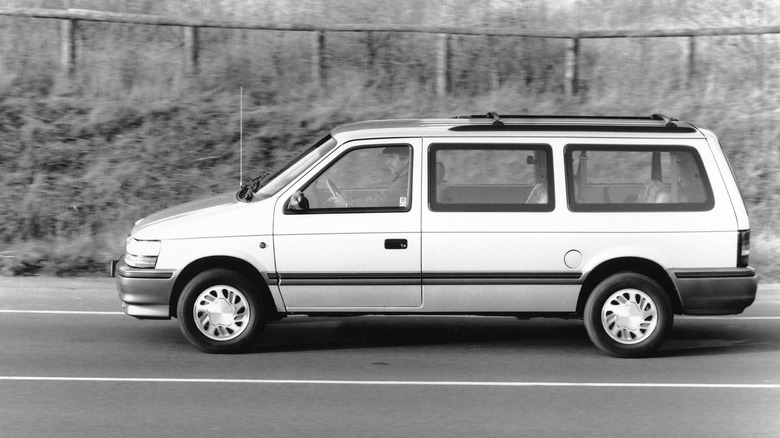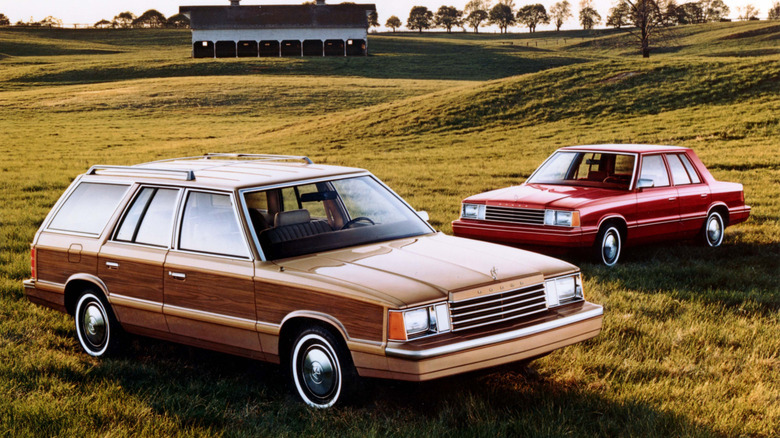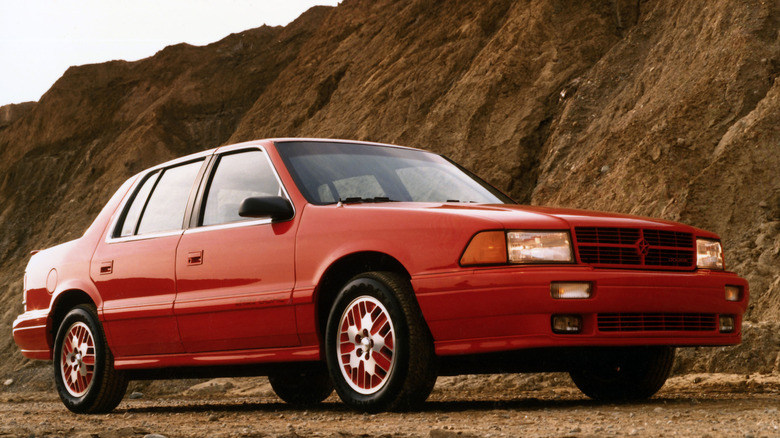
While they might look like one of the boxiest, most pedestrian vehicles from the 1980s, the Chrysler K-car actually represented a massive leap forward for both the auto manufacturer and the automotive industry as a whole. These cars were affordable, practical, and featured a myriad of parts and body configurations, including that of the first successful minivans. In effect, this singular platform is likely the reason why Chrysler is still extant today — but what, exactly, made these boring-looking
cars so special? And what does the "K" even stand for, anyway? Lastly, what cars featured the K-platform, and are any of them particularly noteworthy, even among their peers?
To answer the name question, many platforms use a system of basic lettering, not just Chrysler. For instance, both GM and Mopar had K-platform designations, with the GM variant belonging to the 1975 Cadillac Seville. Then there are the famous Mopars that are known by their body variants, like the classic A- and B-body Plymouths and Dodges. Ultimately, the term "K" follows this trend, being nothing more than an internal letter designation for the chassis code. Similarly, all Chrysler K-cars shared similar traits; namely, they began as front-wheel-drive vehicles with transverse (sideways-mounted) engines, with independent front and semi-independent rear suspension.
So if the name isn't particularly special and the cars don't look terribly interesting, then why are they so important? The short answer is that this was both an innovative and inexpensive platform that featured many body styles to suit multiple audiences, effectively producing dozens of models out of a single underlying chassis. It could be stretched, trimmed, and molded to any shape Chrysler needed, and, in 1984, the K-platform accounted for 1.2 million of the 2.8 million cars sold by the conglomerate, composing nearly half of its total profits alone.
Read more: 5 Cars GM Never Should Have Discontinued
Lee Iacocca's Finest Hour With Chrysler

Chrysler suffered heavily under the crushing weight of the Oil Crisis of the '70s, failing to deliver quality vehicles and ruining its reputation by the turn of the decade. That's when the company turned to Lee Iacocca, a former Ford senior engineer who had a falling-out with Henry Ford II and found himself looking for a job where he could be more independent. Chrysler happily brought him on board to help fix the myriad of problems under the hood, an arrival that coincided with the heyday of badge engineering in the early '80s.
It's this badge engineering concept taken to the extreme that served as the basis for Iacocca's vision. The K-platform was a blank canvas upon which multiple chassis could be fitted, meaning it minimized production times between drastically different vehicles by offering shared underpinnings. Thus, a K-platform car could be anything from a midsize Dodge Aries up to an extended Plymouth Grand Voyager minivan. This not only saved heaps of development costs but also reduced the amount of spare parts inventory required, as having multiple different platforms means building a wider logistics train to support them all.
This is what defined the Chrysler K-platform more than any other: its modularity. The platform eventually found its way onto over 50 different models across all of Chrysler's arms between 1981 and 1995, including such noteworthy names as the Dodge Caravan, Plymouth Reliant, and Chrysler LeBaron, to name a few. One K-platform even ranked among the rarest Mopars to see regular production, namely, a Shelby variant of Chrysler's bizarre-looking ute called the Dodge Rampage.
The Letter That Saved A Company

Chrysler's subcompact Dodge Omni and Plymouth Horizon sold like hotcakes. By contrast, the majority of the company's larger vehicles in the 1970s were holdovers from a bygone era — inefficient, large, rear-wheel-drive models that had been developed during one of the most critical junctures in automotive history. The American buyer had moved on and desired cheap, reliable, fuel-efficient vehicles, and the main source for them came from overseas, not stateside. While the L-platform subcompacts were intended to fight against cars like the Volkswagen Golf, the K-platform targeted the midsize market of sedans and station wagons from its debut— and it didn't stop there.
By far the K-platform's longest-lasting impact came not with a car, but with a van — specifically, the 1984 Chrysler minivan. The automaker was barely surviving on a $1.5 billion grant when the minivan debuted in 1983 for model year '84, and it immediately sent shockwaves throughout the industry. Suddenly, customers could purchase a car-like vehicle with independent suspension that retained the cargo capabilities of a traditional body-on-frame van. This was the creation of a cultural sensation that has lasted ever since. Lee Iacocca had promoted making such a vehicle during his time with Ford, which had only served to grow the rift between him and that company's executives.
Chrysler made no such mistake, however, and heavily marketed the utility of this unique body style while fielding multiple configurations across three brands. It wasn't the first minivan ever produced, but it was certainly one of the most influential designs in history. Few archetypes of any trade last for four decades, much less one as fluctuating as car trends.
Want the latest in tech and auto trends? Subscribe to our free newsletter for the latest headlines, expert guides, and how-to tips, one email at a time.
Read the original article on SlashGear.











